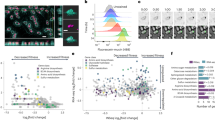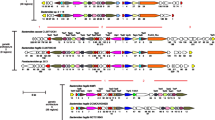Abstract
The mammalian intestinal tract contains trillions of bacteria. However, the genetic factors that allow gut symbiotic bacteria to occupy intestinal niches remain poorly understood. Here, we identified genetic determinants required for Bacteroides thetaiotaomicron colonization in the gut using transposon sequencing analysis. Transposon insertion in BT2391, which encodes a hybrid two-component system, increased the competitive fitness of B. thetaiotaomicron. The BT2391 mutant showed a growth advantage in a mucin-dependent manner and had an increased ability to adhere to mucus-producing cell lines. The increased competitive advantage of the BT2391 mutant was dependent on the BT2392-2395 locus containing susCD homologs. Deletion of BT2391 led to changes in the expression levels of B. thetaiotaomicron genes during gut colonization. However, colonization of the BT2391 mutant promoted DSS colitis in low-fiber diet-fed mice. These results indicate that BT2391 contributes to a sustainable symbiotic relationship by maintaining a balance between mucosal colonization and gut homeostasis.
Similar content being viewed by others
References
Ares, M. 2012. Bacterial RNA isolation. Cold Spring Harb. Protoc. 2012, 1024–1027.
Bacic, M.K. and Smith, C.J. 2008. Laboratory maintenance and cultivation of Bacteroides species. Curr. Protoc. Microbiol. 9, 13c.1.1–13c.1.21.
Bolger, A.M., Lohse, M., and Usadel, B. 2014. Trimmomatic: a flexible trimmer for Illumina sequence data. Bioinformatics 30, 2114–2120.
Coyne, M.J., Chatzidaki-Livanis, M., Paoletti, L.C., and Comstock, L.E. 2008. Role of glycan synthesis in colonization of the mammalian gut by the bacterial symbiont Bacteroides fragilis. Proc. Natl. Acad. Sci. USA 105, 13099–13104.
Coyte, K.Z. and Rakoff-Nahoum, S. 2019. Understanding competition and cooperation within the mammalian gut microbiome. Curr. Biol. 29, R538–R544.
Cullen, T.W., Schofield, W.B., Barry, N.A., Putnam, E.E., Rundell, E.A., Trent, M.S., Degnan, P.H., Booth, C.J., Yu, H., and Goodman, A.L. 2015. Gut microbiota. Antimicrobial peptide resistance mediates resilience of prominent gut commensals during inflammation. Science 347, 170–175.
Cummings, J.H. and Macfarlane, G.T. 1991. The control and consequences of bacterial fermentation in the human colon. J. Appl. Bacteriol. 70, 443–459.
Degnan, P.H., Barry, N.A., Mok, K.C., Taga, M.E., and Goodman, A.L. 2014. Human gut microbes use multiple transporters to distinguish vitamin B12 analogs and compete in the gut. Cell Host Microbe 15, 47–57.
Desai, M.S., Seekatz, A.M., Koropatkin, N.M., Kamada, N., Hickey, C.A., Wolter, M., Pudlo, N.A., Kitamoto, S., Terrapon, N., Muller, A., et al. 2016. A dietary fiber-deprived gut microbiota degrades the colonic mucus barrier and enhances pathogen susceptibility. Cell 167, 1339–1353.
Donaldson, G.P., Lee, S.M., and Mazmanian, S.K. 2016. Gut biogeography of the bacterial microbiota. Nat. Rev. Microbiol. 14, 20–32.
Faith, J.J., Guruge, J.L., Charbonneau, M., Subramanian, S., Seedorf, H., Goodman, A.L., Clemente, J.C., Knight, R., Heath, A.C., Leibel, R.L., et al. 2013. The long-term stability of the human gut microbiota. Science 341, 1237439.
García-Bayona, L. and Comstock, L.E. 2018. Bacterial antagonism in host-associated microbial communities. Science 361, eaat2456.
García-Bayona, L. and Comstock, L.E. 2019. Streamlined genetic manipulation of diverse bacteroides and parabacteroides isolates from the human gut microbiota. mBio 10, e01762–19.
Glenwright, A.J., Pothula, K.R., Bhamidimarri, S.P., Chorev, D.S., Basle, A., Firbank, S.J., Zheng, H., Robinson, C.V., Winterhalter, M., Kleinekathofer, U., et al. 2017. Structural basis for nutrient acquisition by dominant members of the human gut microbiota. Nature 541, 407–411.
Goodman, A.L., McNulty, N.P., Zhao, Y., Leip, D., Mitra, R.D., Lozupone, C.A., Knight, R., and Gordon, J.I. 2009. Identifying genetic determinants needed to establish a human gut symbiont in its habitat. Cell Host Microbe 6, 279–289.
Huang, D.W., Sherman, B.T., and Lempicki, R.A. 2009. Systematic and integrative analysis of large gene lists using DAVID bioinformatics resources. Nat. Protoc. 4, 44–57.
Johansson, M.E.V., Sjövall, H., and Hansson, G.C. 2013. The gastrointestinal mucus system in health and disease. Nat. Rev. Gastroenterol. Hepatol. 10, 352–361.
Koropatkin, N.M., Martens, E.C., Gordon, J.I., and Smith, T.J. 2008. Starch catabolism by a prominent human gut symbiont is directed by the recognition of amylose helices. Structure 16, 1105–1115.
Langmead, B. and Salzberg, S.L. 2012. Fast gapped-read alignment with Bowtie 2. Nat. Methods 9, 357–359.
Lee, S.M., Donaldson, G.P., Mikulski, Z., Boyajian, S., Ley, K., and Mazmanian, S.K. 2013. Bacterial colonization factors control specificity and stability of the gut microbiota. Nature 501, 426–429.
Liao, Y., Smyth, G.K., and Shi, W. 2014. featureCounts: an efficient general purpose program for assigning sequence reads to genomic features. Bioinformatics 30, 923–930.
Love, M.I., Huber, W., and Anders, S. 2014. Moderated estimation of fold change and dispersion for RNA-seq data with DESeq2. Genome Biol. 15, 550.
Lynch, J.B. and Sonnenburg, J.L. 2012. Prioritization of a plant polysaccharide over a mucus carbohydrate is enforced by a Bacteroides hybrid two-component system. Mol. Microbiol. 85, 478–491.
Martens, E.C., Chiang, H.C., and Gordon, J.I. 2008. Mucosal glycan foraging enhances fitness and transmission of a saccharolytic human gut bacterial symbiont. Cell Host Microbe 4, 447–457.
Martens, E.C., Koropatkin, N.M., Smith, T.J., and Gordon, J.I. 2009. Complex glycan catabolism by the human gut microbiota: the Bacteroidetes Sus-like paradigm. J. Biol. Chem. 284, 24673–24677.
Martens, E.C., Lowe, E.C., Chiang, H., Pudlo, N.A., Wu, M., McNulty, N.P., Abbott, D.W., Henrissat, B., Gilbert, H.J., Bolam, D.N., et al. 2011. Recognition and degradation of plant cell wall polysaccharides by two human gut symbionts. PLoS Biol. 9, e1001221.
Peterson, D.A., McNulty, N.P., Guruge, J.L., and Gordon, J.I. 2007. IgA response to symbiotic bacteria as a mediator of gut homeostasis. Cell Host Microbe 2, 328–339.
Porter, N.T., Canales, P., Peterson, D.A., and Martens, E.C. 2017. A subset of polysaccharide capsules in the human symbiont Bacteroides thetaiotaomicron promote increased competitive fitness in the mouse gut. Cell Host Microbe 22, 494–506.
Raghavan, V. and Groisman, E.A. 2010. Orphan and hybrid two-component system proteins in health and disease. Curr. Opin. Microbiol. 13, 226–231.
Rajilić-Stojanović, M., Heilig, H.G., Tims, S., Zoetendal, E.G., and de Vos, W.M. 2013. Long-term monitoring of the human intestinal microbiota composition. Environ. Microbiol. 15, 1146–1159.
Ravcheev, D.A., Godzik, A., Osterman, A.L., and Rodionov, D.A. 2013. Polysaccharides utilization in human gut bacterium Bacteroides thetaiotaomicron: comparative genomics reconstruction of metabolic and regulatory networks. BMC Genomics 14, 873.
Salyers, A.A., Vercellotti, J.R., West, S.E., and Wilkins, T.D. 1977. Fermentation of mucin and plant polysaccharides by strains of Bacteroides from the human colon. Appl. Environ. Microbiol. 33, 319–322.
Serrao, E., Cherepanov, P., and Engelman, A.N. 2016. Amplification, next-generation sequencing, and genomic dna mapping of retroviral integration sites. J. Vis. Exp. 109, e53840.
Singh, R.K., Chang, H.W., Yan, D., Lee, K.M., Ucmak, D., Wong, K., Abrouk, M., Farahnik, B., Nakamura, M., Zhu, T.H., et al. 2017. Influence of diet on the gut microbiome and implications for human health. J. Transl. Med. 15, 73.
Sonnenburg, J.L., Angenent, L.T., and Gordon, J.I. 2004. Getting a grip on things: how do communities of bacterial symbionts become established in our intestine? Nat. Immunol. 5, 569–573.
Sonnenburg, E.D., Sonnenburg, J.L., Manchester, J.K., Hansen, E.E., Chiang, H.C., and Gordon, J.I. 2006. A hybrid two-component system protein of a prominent human gut symbiont couples glycan sensing in vivo to carbohydrate metabolism. Proc. Natl. Acad. Sci. USA 103, 8834–8839.
Sonnenburg, J.L., Xu, J., Leip, D.D., Chen, C.H., Westover, B.P., Weatherford, J., Buhler, J.D., and Gordon, J.I. 2005. Glycan foraging in vivo by an intestine-adapted bacterial symbiont. Science 307, 1955–1959.
Van der Sluis, M., De Koning, B.A.E., De Bruijn, A.C.J.M., Velcich, A., Meijerink, J.P.P., Van Goudoever, J.B., Büller, H.A., Dekker, J., Van Seuningen, I., Renes, I.B., et al. 2006. Muc2-deficient mice spontaneously develop colitis, indicating that MUC2 is critical for colonic protection. Gastroenterology 131, 117–129.
Wexler, A.G., Schofield, W.B., Degnan, P.H., Folta-Stogniew, E., Barry, N.A., and Goodman, A.L. 2018. Human gut Bacteroides capture vitamin B12 via cell surface-exposed lipoproteins. Elife 7, e37138.
Wu, M., McNulty, N.P., Rodionov, D.A., Khoroshkin, M.S., Griffin, N.W., Cheng, J., Latreille, P., Kerstetter, R.A., Terrapon, N., Henrissat, B., et al. 2015. Genetic determinants of in vivo fitness and diet responsiveness in multiple human gut Bacteroides. Science 350, aac5992.
Xu, J., Bjursell, M.K., Himrod, J., Deng, S., Carmichael, L.K., Chiang, H.C., Hooper, L.V., and Gordon, J.I. 2003. A genomic view of the human-Bacteroides thetaiotaomicron symbiosis. Science 299, 2074–2076.
Zheng, D., Liwinski, T., and Elinav, E. 2020. Interaction between microbiota and immunity in health and disease. Cell Res. 30, 492–506.
Zhu, Y., Suits, M.D.L., Thompson, A.J., Chavan, S., Dinev, Z., Dumon, C., Smith, N., Moremen, K.W., Xiang, Y., Siriwardena, A., et al. 2010. Mechanistic insights into a Ca2+-dependent family of alpha-mannosidases in a human gut symbiont. Nat. Chem. Biol. 6, 125–132.
Zhu, W., Winter, M.G., Spiga, L., Hughes, E.R., Chanin, R., Mulgaonkar, A., Pennington, J., Maas, M., Behrendt, C.L., Kim, J., et al. 2020. Xenosiderophore utilization promotes Bacteroides thetaiotaomicron resilience during colitis. Cell Host Microbe 27, 376–388.
Acknowledgements
This study was supported by the Fellowship of Suh Kyungbae Foundation to JHP, the POSCO Science Fellowship of POSCO TJ Park Foundation to JHP; and by a grant (2020R1I1A1A-01052942) of the Basic Science Research Program through the National Research Foundation of Korea (NRF) funded by the Ministry of Education, Republic of Korea, to YJC. SJK, JYH, and SHC were recipients of the BK21 Fellowship from the Ministry of Education.
Author information
Authors and Affiliations
Contributions
JHP initiated the project. JHL, SJK, JYH, and SHC performed the experiments. YJC helped interpret the experimental results. JHL, YJC, and JHP wrote the manuscript.
Corresponding author
Ethics declarations
Conflict of Interest The authors declare that the research was conducted in the absence of any commercial or financial relationships that could be construed as a potential conflict of interest.
Ethcial Statements All animal experiments were performed as approved by the Institutional Animal Care and Use Committee (IACUC) of Seoul National University (approval number: SNU-200504-6-6).
Additional information
Supplemental material for this article may be found at http://www.springerlink.com/content/120956.
Electronic supplementary material
Rights and permissions
About this article
Cite this article
Lee, JH., Kwon, SJ., Han, JY. et al. A mucin-responsive hybrid two-component system controls Bacteroides thetaiotaomicron colonization and gut homeostasis. J Microbiol. 60, 215–223 (2022). https://doi.org/10.1007/s12275-022-1649-3
Received:
Revised:
Accepted:
Published:
Issue Date:
DOI: https://doi.org/10.1007/s12275-022-1649-3




